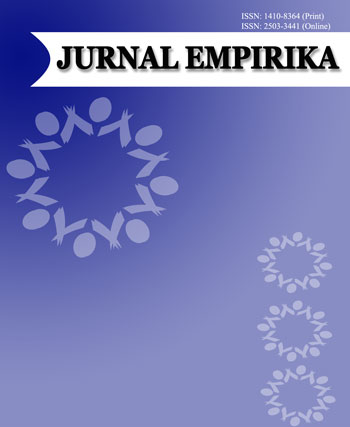NIKAH MUDA DALAM PANDANGAN MASYARAKAT DESA KEPULAUAN SIMEULUE (Studi Kasus di Desa Lubuk Baik, Kec. Alafan, Simeulue, Aceh)
 Abstract: 175
/
Abstract: 175
/  Abstract: 192
Abstract: 192
DOI:
https://doi.org/10.47753/je.v8i2.143Keywords:
Young Marriage Phenomenon, Simeulue Community View, AcehAbstract
Young marriage, in the view of the Simeulue community, is a new fact that is present today in a society that aims to avoid violence among teenagers. Young marriage is a sacred bond performed by a pair of teenage men and women who should not be married yet. The purpose of this study is to explain the views of the Simeulue community about the factors that influence the rise of young marriage and the social impact of young marriage. This research uses qualitative methods with data collection techniques through observation, interviews, and documentation. The results showed that the factors that influence parents to allow children to marry young are economic factors and environmental factors. Meanwhile, the impact that occurs due to young marriage is the disconnection of children's education and the family's economic conditions that are far from sufficient to meet family needs and cause disharmonious households, even divorce.References
Aiman, U., Sri Wahyuni, L., Muthi, A., Ghofur, I., Ushuluddin dan Adab, F., & Syekh Nurjati Cirebon, I. (2023). Analisis Dampak Nikah Muda terhadap Keadaan Mental Pasangan Suami Istri. Gunung Djati Conference Series, 21, 121–131.
Amirah, N., & Nawireja, I. K. (2022). Dampak Ponsel Pintar terhadap Perkawinan Anak Perempuan di Pedesaan. Jurnal Sains Komunikasi Dan Pengembangan Masyarakat [JSKPM], 6(6), 612–626. https://doi.org/10.29244/jskpm.v6i6.1032
Br Ginting, S. M., & Baiduri, R. (2023). Fenomena Kawin Muda Di Era Digital Bagi Etnis Karo di Desa Pekan Sawah Kecamatan Sei Bingai Kabupaten Langkat. Jurnal Antropologi Sumatera, 19(2), 108. https://doi.org/10.24114/jas.v19i2.43916
Creswell. (2018). Research and Design Qualitative, Quantitative and Mixed Methods Approaches. In Thousand Oaks California.
Doni Azhari, Sugitanata, A., & Aminah, S. (2022a). Trend Ajakan Nikah Muda : Antara Hukum Agama dan Hukum Positif. The Indonesian Journal of Islamic Law and Civil Law, 3(1), 1–17. https://doi.org/10.51675/jaksya.v3i1.189
Doni Azhari, Sugitanata, A., & Aminah, S. (2022b). Trend Ajakan Nikah Muda : Antara Hukum Agama dan Hukum Positif. The Indonesian Journal of Islamic Law and Civil Law, 3(1), 1–17. https://doi.org/10.51675/jaksya.v3i1.189
Fitriya, A., Hidayat, Y., & Widaty, C. (2022). Tradisi Basasanggan Dalam Acara Perkawinan di Desa Pimping Kecamatan Amuntai Utara Kabupaten Hulu Sungai Utara. Jurnal Empirika, 6(1), 56. https://doi.org/10.47753/je.v6i1.116
Intan Purnamasari. (2019). Fenomena Pernikahan Di usia Muda Dikalangan Masyarakat. In uiN Ar-RaniryN Ar-Raniry. UIN Ar-Raniry.
Masrizal, M. (2015). Pengendalian masalah sosial melalui kearifan lokal (Sabirin (ed.)). Syiah Kuala University Press.
Mubasyaroh. (2016). Analisis Faktor Penyebab Pernikahan Dini dan Dampaknya Bagi Pelakunya. Jurnal Pemikiran Dan Penelitian Sosial Keagamaan, 7(2), 385–411.
Muchsin, A. Y., Sufyan, A. F. M., & Hariyanto, E. (2019). Urgensi Isbat Nikah Bagi Pasangan Yang Menikah Dibawah Umur Di Kabupaten Pamekasan. Al-Manhaj: Journal of Indonesian Islamic Family Law, 1(1), 13. https://doi.org/10.19105/al-manhaj.v1i1.2653
Pratiwi, D. (2021). Pertunjukan Organ Tunggal Pada Acara Pernikahan di Kelurahan Indralaya Mulya Kabupaten Ogan Ilir. Jurnal Empirika, 5(2), 83. https://doi.org/10.47753/je.v5i2.96
Stevani, N. D. (2018). Faktor-Faktor Remaja Hamil Di Luar Nikah Di Kampung Masjid Kelurahan Pesawahan Kecamatan Teluk Betung Selatan Bandar Lampung (Study Kasus 3 Remaja). In Skripsi. Raden Intan Lampung.
Vionita, Y. O. (2020). Pandangan Masyarakat Tentang Pernikahan Dini Sebagai Implementasi Undang-Undang Perkawinan Di Desa Balun Kecamatan Turi. Jurnalmahasiswa.Unesa.Ac.Id, 08, 764–778. https://jurnalmahasiswa.unesa.ac.id/index.php/jurnal-pendidikan-kewarganegaraa/article/view/35779
Downloads
Published
Issue
Section
License
Articles published in Jurnal Empirika are licensed under the International License of Creative Commons Allowance-ShareAlike 4.0. The author is free to use any media to copy, change, or redistribute the paper, provided the author gives credit to the original author and this journal, links to the license, shows if modifications have been made, and redistributes it in the same permission. The author grants the right to any third party to use their posts following the Creative Commons Attribution-Share Alike International 4.0.












